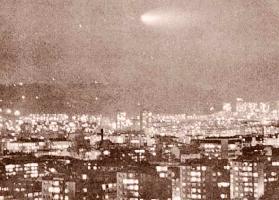

![]()
Thousands of dirty snowballs from outer space are bombarding Earth’s atmosphere every day, adding water to Earth’s air and seas, scientists reported last week. Over billions of years of planetary history, they said, the torrent of extraterrestrial slush might have played a crucial role in filling the oceans and nurturing life on the planet.
 Unlike
large comets the relatively small snowballs are hard to observe
Unlike
large comets the relatively small snowballs are hard to observe
The
newly discovered snowballs are small, comet-like objects about 40 feet in
diameter, or the size of a small house. Unlike large comets such as Halley or
Hale-Bopp whose icy core is estimated to be 25 miles wide, the small comets are
very hard to see. Until now, astronomers could do little more than speculate
about them.
The discovery of the new class of cometary objects was made by NASA’s Polar spacecraft, which was launched in February 1996. The findings were reported last week at the spring meeting of the American Geophysical Union in Baltimore.
"We have a large population of objects in the Earth’s vicinity that have not been detected before," said Dr. Louis A. Frank, a physicist at the University of Iowa who first theorised about the phenomenon in 1986 and pushed the observations now confirming their reality.
Because the new comets break up at heights of 600 miles to 15,000 miles above Earth, they are no danger to people on the ground or to astronauts, spacecraft or airplanes. At that altitude, the snowballs fall apart into fragments. Exposure to sunlight then vapourises the icy rain into huge clouds that are eventually dispersed by the atmosphere’s winds.
Thus, the cosmic rain eventually becomes part of terrestrial downpours.
Frank estimated that during every 10,000 to 20,000 years of Earth’s history, the cosmic rain added one inch of water to Earth’s surface, which adds up to miles of water over geologic time.
Comets are remnants of creation that are made up largely of water ice and cosmic dust. Trillions of them are thought to travel, beyond the planets, in belts in the distant regions of the solar system. Over the centuries, astronomers on Earth have observed them rushing through the inner solar system only fleetingly.
Unlike large comets and asteroids that hit Earth, the relatively small snowballs apparently undergo little or no heating from atmospheric friction, making them hard to observe but also possibly protecting any organic chemicals they may contain from heat damage.
Organic chemicals are carbonrich molecules and the evolutionary precursors of life. Astronomical observations have recently suggested that the ices of large comets are rich in organic chemicals.
Thus, the small new comets are seen as probably having fallen on the aboriginal Earth in vast numbers, sowing organic precursors for what eventually became the planet’s riot of biological diversity.
"This relatively gentle ‘cosmic rain’ - which possibly contains simple organic compounds - may well have nurtured the development of life on our planet," Frank said in a statement.
The discovery of the small impacting comets fills out an emerging picture of Earth as existing in a kind of cosmic shooting gallery that includes some very large intruders. Scientists analysing once-secret military data recently discovered that the planet was continually struck by speeding boulders that explode in blasts the size of atomic detonations, and that the observed rate of bombardment was about 12 events a year.
Frank proposed his theory of small comets in 1986 to explain the existence of dark spots, which he called "atmospheric holes," in images of Earth’s sunlit atmosphere. He first detected these holes while analysing data from NASA’s Dynamics Explorer I spacecraft.
He theorised that the holes were caused as small comets disintegrated in the upper atmosphere.
The resulting water vapour momentarily absorbed the solar radiation scattered in the upper atmosphere, he theorised, preventing it from reaching his camera and resulting in a dark spot on the image. The holes had diameters of 15 to 25 miles.
His theory ignited wide-ranging controversy. Many scientists discounted the holes as an instrument problem. But the new images from the Polar spacecraft include observations of atmospheric holes in much greater detail than before, suggesting they are very real.
"These results certainly vindicate Lou Frank’s earlier observations," said Donahue of the University of Michigan.
Frank is the principal scientist for the visible imaging system of the Polar satellite, which circles in an elliptical orbit anywhere from 3,200 to 32,000 miles above Earth. The satellite is most distant from Earth as it passes over the northern polar regions, its primary target.
The imaging system has tracked the small comets in both ultraviolet and visible wavelengths of light as they disintegrate, finding their trails criss-crossing high above the planet.
Using a special filter that detects a particular signature of visible light emitted by water molecules, Frank discovered that the snowballs consisted mainly of water.
"This is a very exciting result but I’d like to see confirmation by other techniques, given that there was so much controversy in the past," Dr. George Withbroe, director of the NASA programme that runs the Polar spacecraft, said in an interview. "We need to look closely at measurements from other sensors to find out if they see related signatures in the atmosphere."
Continue to Plus page 3 - They say Sardiel was a charming man
Return to the Plus contents page
![]()
| HOME PAGE | FRONT PAGE | EDITORIAL/OPINION | NEWS / COMMENT | BUSINESS
Please send your comments and suggestions on this web site to
info@suntimes.is.lk or to
webmaster@infolabs.is.lk